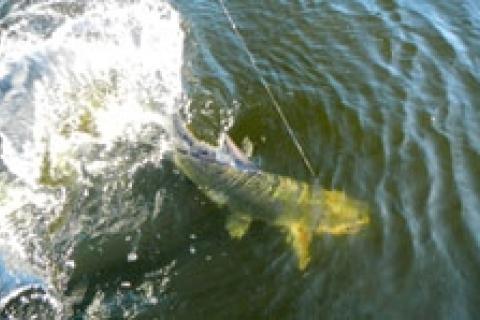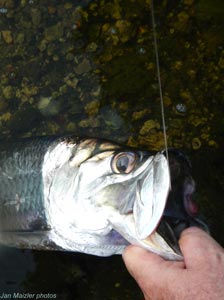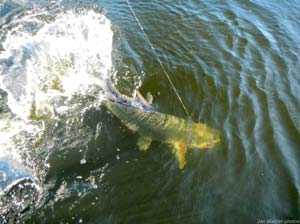
 The international range of tarpon (megalops atlanticus) stretches from West Africa to the southeastern USA, Gulf of Mexico, Central America, the Caribbean and northern South America. In those locales, tarpon are often pursued by casting methods like fly fishing, as well as plugs and jigs on spinning and baitcasting gear. Depending on the water depth, these presentations are often deployed throughout the entire water column. Any anglers even vaguely familiar with tarpon have come to know depictions of the Silver King jumping on the flats off the Florida and the Yucatan. Florida anglers often pursue tarpon off SOFLA bridges and in the early mornings and dusk off beaches right near ocean inlets.
The international range of tarpon (megalops atlanticus) stretches from West Africa to the southeastern USA, Gulf of Mexico, Central America, the Caribbean and northern South America. In those locales, tarpon are often pursued by casting methods like fly fishing, as well as plugs and jigs on spinning and baitcasting gear. Depending on the water depth, these presentations are often deployed throughout the entire water column. Any anglers even vaguely familiar with tarpon have come to know depictions of the Silver King jumping on the flats off the Florida and the Yucatan. Florida anglers often pursue tarpon off SOFLA bridges and in the early mornings and dusk off beaches right near ocean inlets.
Most anglers have a bit less familiarity with tarpon as bottom feeders of dead bait. In south Florida, it's not uncommon for tarpon to congregate around charter boat docks from Miami to Key West to regularly feed on dressed-out fish carcasses. While this is less glamorous than the tarpons' postcard images, it confirms to savvy anglers that these gamesters are responsive to chumming and fishing with cut finfish baits.
Background
In the "old days" of southwest Florida, savvy guides would toss out a double-hooked dead scored mullet to bottom fish for tarpon. The tackle at that time was heavy conventional gear fished in free spool with the clicker on. This seemingly heavy handed method relied on long waits for pickups on the bottom, and deeply hooked fish that were injured by big hooks and wire leader. This was the method of choice early this century in places like downtown Fort Myers, but with huge developments in tactics, hooks and tackle, cut baiting for tarpon can be an efficient and safe method for taking the Silver King. I have used cut bait historically when either the fish are not striking artificials and/or when the fish have gone deep or grown unresponsive in the back bays.
Tarpon Fishing Methods
Bait – The most realistic cut bait presentation is a palm-sized portion of finfish meat cut in chunks, finger or squared fillet shapes. Whether you're fishing in Florida, Central America or the Caribbean, cut mullet, menhaden, catfish and "whitebaits" like pilchards, herring, sardines and sprat are extremely effective. Be aware that smaller whitebaits are best fished minus heads and tails to let out better scent.
Tackle – Cut bait specialists have found through extensive experimentation that spinning tackle offers the most natural "drop" and "free-spool" applications. Tarpon tend to drop the baits if they feel a sharp hook and spinning tackle gives the gamesters less free spool resistance than conventional tackle.
Deployment – Cut baiting for tarpon begins and remains a bottom-based presentation. The dimensions and weight of the cut bait will be determined by the size of the tarpon, the depth of the water column, and the prevailing current. In using light tackle as small as 12-pound line, avoid using any sinkers – even detachable ones – and use a dense chunk of bait free-lined into depths as great as 20 to 30 feet.
If the water is only 10 to 15 feet deep, a square or finger shaped (and sized) "fillet-style" cut bait will reach the bottom as well, but more slowly than a chunk. The lighter cut baits will get down more quickly if the angler pulls out a pre-measured amount of line through the rod tip and lets the bait sink naturally from the "pile" on the water surface. After the bait reaches bottom, your next step will depend on the hook style you're using. With a J-hook, leave the spinning reel with the bail open. When a tarpon pickup starts, let the fish have line for a few seconds, then close the bail and strike the fish forcefully a few times.
 |
| Monofilament line has the stretch to make rehooking possible when tarpons jump and thrashes during the battle. |
Circle hooks are fished on the bottom with the (spinning reels) bail closed. In this case, the strike and movement of the fish often cause the circle hook to lodge itself in the corner of its' jaw and the fish hooks itself.
Tactics – Present your bait in areas where tarpon can be seen rolling or cruising and marked on your fishfinder as well. Chumming almost always helps to get the tarpon in a striking mood. I always chum with the same type fish I'm using for bait. It's best to chum often and at regular intervals. Make the size of your chum smaller than your bait. If there are many tarpon around, chum some more. If there are fewer tarpon or smaller sized fish, chum less so as to keep their appetites optimal. It will be obvious when your chum works: huge swirls on the chum, boatside and dockside splashing rolls and strikes are hard to miss! "Outdoors"-quality scissors are your best cutting tool for final chumming applications.
If the tarpon get chummed right to the surface, all that's necessary is a small piece of chum-sized bait left to sink naturally. Since the strike will be immediate, brace yourself! I have determined that J-hooks work best in these frenzies, causing far less jumped-off fish. And there is no gut-hooking, as I strike my fish within seconds of the take.
Leaders – I always recommend fluorocarbon leader; regardless of the water clarity. My anecdotal impression is that "fluoro" has better abrasion resistance and sink rate than "mono." Here's how I rig my leaders: Since, I've never used anything heavier than 12-pound tackle for over 30 years – even on the largest tarpon – a long "fighting-length" leader is important to me. I double my running line for a length of 10 feet, and then go to a 5-foot length of leader. For small tarpon, I use 30-pound. For medium tarpon, I use 50-pound. For large tarpon, I add 12 inches of 80-pound fluoro to my 50-pound leader.
Line – I have been using braided line since its introduction into the market. My opinion is that with any jumping, lunging, free-wheeling game fish like tarpon, mono is a better. Here's why: Braids' greatest assets are its non-stretch for strike detection, power transmission and, of course, abrasion resistance. Ironically, the braids' non-stretchiness is what causes so many hooks to "slingshot" out of the tarpon's mouth when it jumps and thrashes during the battle. This even happens when the angler bows to the tarpon. Many anglers don't realize that tarpon often throw the hook – within their own bucket-like mouth – and rehook themselves in that same cavern. Mono line has the stretch to make this rehooking more possible. The recoil that tighten braided line creates has meant more thrown hooks for myself and many other anglers.
- 17302 views

